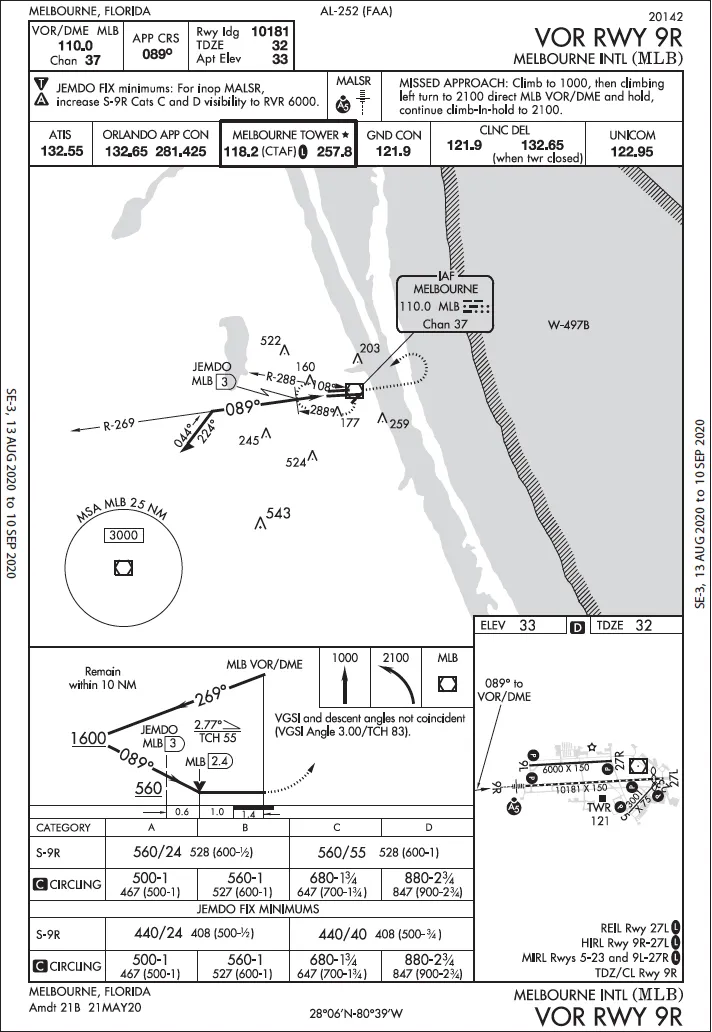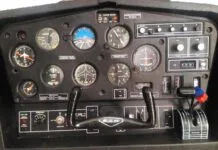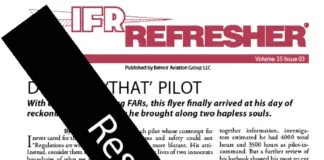Mins Deep Dive Deep Thought
I read your “Deep Dive into Mins” article in the July issue in which you cite AIM 5-4-7.c. I believe you meant 5-4- 7.a. since I can see no reference in paragraph c for the category minimums you were discussing.
Also, I cannot see any reference in this section of the AIM in which the FAA authorizes the use of lower category minimums while operating at a speed in a higher category. In fact as I read the relevant paragraph it says the opposite, “For example, an airplane which fits into Category B, but is circling to land at a speed of 145 knots, must use the Category D minimums.”
Thanks for an excellent magazine on which I’ve relied for the last 15 years.
Dave Simpson
Escondido, CA
You might need to get an updated copy of the AIM. While the article didn’t specify the exact date, it did refer to a change effective “earlier this year,” which is the January 2020 update. In that update, the quotation you reference changes “must use” to “should use” and add paragraph c that goes on to discuss using lower minimums than your speed previously mandated.
I’m confused why Luca Bencini-Tibo would use the terms DH and MDH, rather than DA and MDA in regards to GA airplanes. It has always been my understanding that any time, in flight, that you reference an “H” (for Height), you are referencing a radar altimeter, not a barometric altimeter. Typically one finds a DH in a Category II or III approach, not something that is typically flown in GA.

The two approaches referenced in the article both have Decision Altitudes published, not Decision Heights. Yes, there is a HAT (Height Above Touchdown) in smaller print, but that is informational, not operational.
Thanks for your great publication; I enjoy every issue.
Roger Harris
Stockton, NJ
Although specific approaches were used as examples, this was a discussion about minimums in general. Thus, it’s appropriate to discuss minimums in terms of height above the ground, since that’s the controlling factor in procedure design. For example, if we said that the minimums for an approach into Leadville, CO (KLXV) were 10,184 feet and the approach into Fort Lauderdale Executive took you to 427 feet, which would you say had lower minimums? You don’t know without more information. But, if we said Leadville offered an DH of 300 feet, while the approach into Fort Lauderdale Executive offered a DH of 500 feet, you’d know without further reference.
Clearly, as you note, you shouldn’t actually fly these approaches based on height from a radar/radio altimeter, but using the height (not MSL altitude) is useful in comparing them and generically discussing minimums. Perhaps we should have stressed that.
Also note that the minimum height is shown on all charts, whether it’s a DH or an MDH. This not only helps in comparing approaches, but in determining if the weather is above minimums, because terminal ceilings are given altitude AGL, which doesn’t compare well with a DA or MDA. You even noted that the height is provided on the chart and is informational, not operational.
Whoever oversaw the recent rewrite of AIM 5-4-7 must be seriously deranged. Since obstacle protection is only guaranteed if you stay within the circling area established for your approach category, and since your radius of turn is dependent solely on your TAS at a constant IAS and angle of bank, encouraging pilots to fly as fast as they want to as long as they can determine some alternate means to stay within the circling area sounds both insane and dangerous. In particular, increasing your angle of bank when you are 500 feet above the deck (at night in low visibility) sounds particularly deadly.
Bennett E. Taber
San Francisco, CA
Yeah, I wrestled with this before writing my Remarks in which I essentially said that I think it can be safe. I’m going to stick with that.
First, pushing your approach category to one higher on a straight-in approach to a landing is almost certainly safe, right? An issue for a straight-in approach could arise, however, on the missed. This is most likely to come up, not on a Category B aircraft wanting to fly to Category A mins, and is also unlikely on a Category C flying to Category B? It’s more likely to arise if there is no Category D, tempting the pilot to try it using Category C mins.
Who’s flying Category C and D aircraft? I’m going to say it’s more than likely a well-trained, experienced pilot. So, first off, one hopes that a decision to fly an approach using lower category mins will be made with some consideration for the risks involved. Sure, there’s always the rogue cowboy, but in general I think this is a reasonable assumption.
Finally, look at the table at the top of Page 17 in the article (reproduced here), showing the approach design criteria for each category. Note that the speeds we use as VREF to determine category are really VAT, at threshold or speed “over the fence” which is usually slower than the rest of the approach. Look at the line for Category B, for example. While the top VAT is 120 knots, the procedure design assumes it could be as high as 130 to 150 knots on the missed. That’s a lot of leeway that provides room for safety.
In fact, if a pilot is cautious and aware of the conditions and compensates accordingly, even a circle-to-land can be done safely using a lower-thanreal approach category.
Take the example of a certificated Category C airplane at an airport without Category C minimums, and choosing to circle anyway using Category B minimums. Those provide clearance for speeds up to 135 knots, even while the Category B specifies a maximum of 120 knots VAT. So, if I’m flying a 130-knot airplane, I’ve got to be acutely aware of my groundspeed and other factors, but as long as I’m taking all those factors into account, including bank angle, there’s no reason I couldn’t safely execute a circleto-land at a Category B airport.
You mention doing this at night. Fewer of us will circle at night. Adding the challenges of using a lower approach category and, well, I have to agree with you that it’s not the most prudent thing one could choose to do. I wouldn’t. —FB
What’s That Barb Mean?
Regarding Fred Simonds’ July 2018, article “Fly the Hook” about procedure turns. You’re kidding right? … or using literary license? I cannot imagine a new instrument-rated pilot, let along his CFII, not knowing what a procedure turn or the barb on the chart is.
But, if it’s true that neither the student nor his instructor were familiar with a procedure turn, I’d have to say that’s a clear case of CFI malpractice. So what if there aren’t many approaches with procedure turns in the area. Go find a VOR somewhere, and for Pete’s sake there must be an ILS somewhere with a PT. Fly one in the sim. Or, just make one up; it’s not difficult.
Mitchell Gossman
St. Cloud, MN

Unfortunately, neither supposition is correct. The discussion was at an IMC Club meeting, as noted in the article. The pilot I talked with apparently flew very few VOR approaches. I expect he had a lot of GPS approaches under his belt, though. Today, almost all the VOR approaches in South Florida are discontinued. Regardless, though, he was sincere in asking what that hook on the chart meant.





